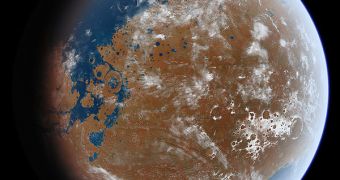According to a new series of satellite observations, it may be that the Red Planet hosted liquid lakes on its surface more than three billion years ago, astronomers say. In a paper published in the latest issue of the journal Geology, the experts emphasize that the research demonstrates the time frame – which was previously thought to be too cold and arid to support the appearance of lakes – was in fact a lot milder than estimated. This would have allowed for lakes made of molten ice to endure on the surface of Mars.
The researchers, from the Imperial College London (ICL) and University College London (UCL), demonstrate that the data available on the Red Planet's history up until now are in tune with the new idea. The lakes might have existed up to three billion years ago, in a time frame that is known among experts as the Hesperian Epoch. The group believes that several large lakes, each about 20 kilometers in diameter, adorned a portion of Mars just below the planet's equator, AlphaGalileo reports.
“Most of the research on Mars has focused on its early history and the recent past. Scientists had largely overlooked the Hesperian Epoch as it was thought that Mars was then a frozen wasteland. Excitingly, our study now shows that this middle period in Mars’ history was much more dynamic than we previously thought,” ICL Department of Earth Science and Engineering Professor, Dr. Nicholas Warner explains. He has also been the lead author of the new scientific paper.
Originally, investigations hinted that Mars lost most of the conditions that allowed for lakes to form between four and 3.8 billion years ago, just before the beginning of the Hesperian Epoch. It was then widely believed that the entire time frame maintained the same general conditions on Mars, so investigators from research groups around the world largely forgot about this period. The new data were collected from the NASA Mars Reconnaissance Orbiter (MRO), which surveyed a feature located near Ares Vallis, a 2,000-kilometer gorge on the Martian equator.
“We can now model the 3D shape of Mars’ surface down to sub-meter resolution, at least as good as any commercial satellite orbiting the Earth. This allows us to test our hypotheses in a much more rigorous manner than ever before,” UCL Department of Space Climate Physics (DSCP) Mullard Space Science Laboratory Professor, Jan-Peter Muller, explains. His work was to map the shape of the Red Planet's surface in 3D. Funding for the investigation came from the Science and Technology Facilities Council, the Royal Society and the Leverhulme Trust.

 14 DAY TRIAL //
14 DAY TRIAL //